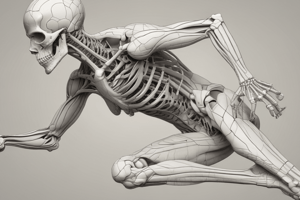Podcast
Questions and Answers
What is flexion?
What is flexion?
A movement that decreases a joint angle, usually in the sagittal plane.
What is extension?
What is extension?
A movement that straightens a joint and generally returns a body part to the zero position.
Define abduction.
Define abduction.
The movement of a body part in the frontal plane away from the midline of the body.
What is adduction?
What is adduction?
What is elevation?
What is elevation?
What is depression?
What is depression?
Define protraction.
Define protraction.
What is retraction?
What is retraction?
What is rotation?
What is rotation?
Define supination.
Define supination.
What is pronation?
What is pronation?
What does opposition mean in anatomical terms?
What does opposition mean in anatomical terms?
What is dorsiflexion?
What is dorsiflexion?
Define plantar flexion.
Define plantar flexion.
What is inversion in foot movement?
What is inversion in foot movement?
What is eversion in foot movement?
What is eversion in foot movement?
What is the endomysium?
What is the endomysium?
What is perimysium?
What is perimysium?
Define epimysium.
Define epimysium.
What is a prime mover?
What is a prime mover?
What is a synergist?
What is a synergist?
Define antagonist.
Define antagonist.
What is a fixator?
What is a fixator?
Study Notes
Joint Movements
- Flexion: Decreases joint angle, typically in the sagittal plane.
- Extension: Straightens a joint, returning a body part to the zero position.
- Abduction: Movement away from the body's midline in the frontal plane.
- Adduction: Movement toward the body's midline in the frontal plane.
- Elevation: Raises a body part vertically in the frontal plane.
- Depression: Lowers a body part vertically in the frontal plane.
- Protraction: Anterior movement of a body part in the transverse plane.
- Retraction: Posterior movement of a body part in the transverse plane.
- Rotation: Bone spins on its longitudinal axis.
- Supination: Forearm movement that turns the palm anteriorly.
- Pronation: Forearm movement that turns the palm posteriorly.
- Opposition: Movement of the thumb to touch the tips of the other fingers.
- Dorsiflexion: Foot movement elevating the toes.
- Plantar Flexion: Foot movement pointing the toes downward.
- Inversion: Foot movement tipping medially, soles facing each other.
- Eversion: Foot movement tipping laterally, soles facing away from each other.
Connective Tissue in Skeletal Muscles
- Endomysium: Thin sleeve of loose connective tissue surrounding each muscle fiber.
- Perimysium: Thicker connective tissue that wraps muscle fibers into bundles known as fascicles.
- Epimysium: Connective tissue layer encasing the entire muscle.
Muscle Actions
- Prime Mover (Agonist): Main muscle generating force for a specific joint action (e.g., brachialis in elbow flexion).
- Synergist: Muscle aiding the prime mover; multiple synergists can yield greater power than a single larger muscle.
- Antagonist: Muscle opposing the prime mover (e.g., triceps brachii during elbow flexion when brachialis is the prime mover).
- Fixator: Muscle stabilizing a bone to maintain posture or position during movement.
Muscle Study Requirements
- Understand the origin, insertion, action, and innervation of each muscle listed in the laboratory manual.
Studying That Suits You
Use AI to generate personalized quizzes and flashcards to suit your learning preferences.
Related Documents
Description
Prepare for Quiz 2 in BSC2085L Anatomy-Physiology 1 Lab with this study guide. It covers essential movements such as flexion, extension, abduction, and adduction, crucial for understanding joint actions. Review these concepts to excel in your lab assessments.




